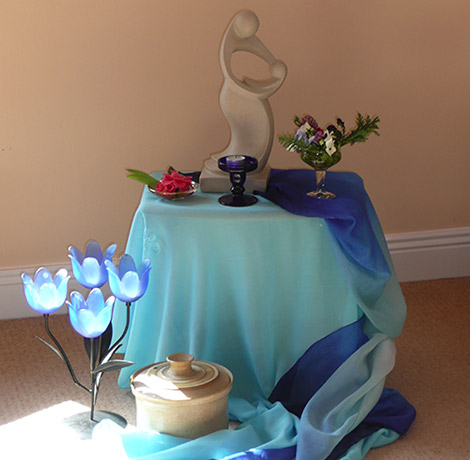A nineteenth century Coach House has been converted and now houses a prayer room, a library, meeting rooms. Guests staying in the hermitages have access to the Coach House and use of its facilities.
Considered to be the most beautiful space in the Hermitage Centre, the Prayer Room overlooks part of the Glendalough valley.
It contains a tabernacle of bog yew which had been preserved for centuries in a bog in the West of Ireland. This houses the Blessed Sacrament linking us to the Eucharistic Presence as well as to our ancient roots in early Irish Christianity and even beyond to the primal sense of worship felt by our ancestors in this sacred landscape.
The Prayer Room also contains two pieces of sculpture by Brother Joseph McNally, one linked with a legend of St. Kevin and the other a miniature statue of Our Lady.
People have remarked on the sense of being enfolded in an atmosphere of beauty and of peace as they enter the sacred space of the Prayer Room.

The library is small but well-stocked and contains titles in the following areas: spirituality, prayer, scripture, Celtic spirituality, women’s spirituality, ecology and poetry. Art supplies and a CD player are also available.
Guests are welcome to browse in the library or to borrow books or materials to use in their Hermitages during their stay.

A meditation garden lies in the grounds of the parish church adjacent to the Hermitage Centre. Inspired by the great monastic tradition of the past, it has been designed to provide an open air, secluded, contemplative space.
The ever-changing beauty of nature provides us with one of the most powerful doorways to prayer and spirituality. The meditation garden is a place where the wisdom of nature, scripture and the spiritual heritage of Glendalough are combined in harmony.

The theme of the garden is journey. It provides the pilgrim with four separate paths, inviting one on an outward journey but also to an individual, inner journey:
It also provides an opportunity to walk in the footsteps of Jesus and pray with him his seven last words.
Bringing the journey of life to the present, there is a sculpture representing the destruction of the twin towers on 9/11/2001. This monument marks the tragedy and challenge to peace posed by this event and is located in the context of a path reflecting on the defining choices we make on our journey today.
The garden was designed by David Shortall and the sculptures were designed and directed by Br. Joseph McNally.
A significant part of the meditation garden is a very beautiful labyrinth. The labyrinth is an ancient religious symbol and throughout time has reflected human beings’ search for meaning and for the source and centre of our lives.
Going on pilgrimage is also part of many religious traditions. For centuries, people have walked to holy places in search of peace, healing, to reflect on life or to deepen their spiritual experience. In the Christian tradition, many people have sought to make a pilgrimage to Jerusalem.
In the Middle Ages, when pilgrimage to Jerusalem was difficult or impossible because of wars and poverty, many cathedrals created labyrinths which people walked as the “road to Jerusalem.”
A labyrinth is a sacred path leading to the centre and out again. To walk a labyrinth is a form or walking prayer or meditation, a way of becoming more aware of the Source of our Being, the eternal presence in which we live.

As we walk, we experience that, as in life, there are many twists and turns involving changes of direction and perspective. At times, the sense is that one is going backwards yet each new phase brings one closer to one’s goal. Having reached the centre of the labyrinth, we pause to receive from our Source and are nourished and renewed to turn again and face outwards towards life’s challenges.